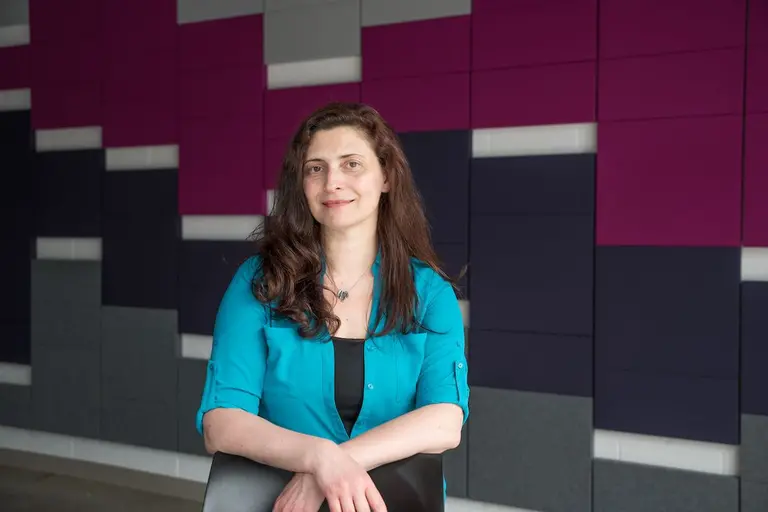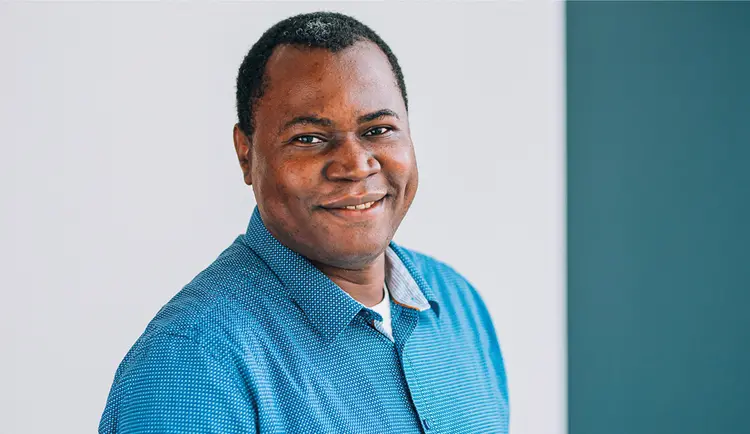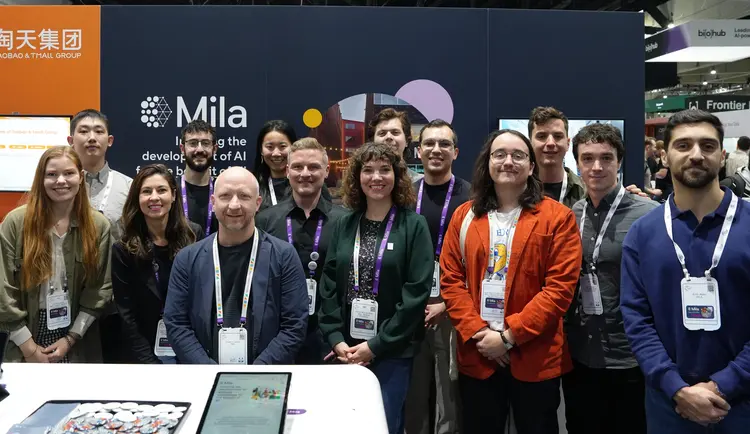
UDEMNOUVELLES | JEFF HEINRICH
From math geek in the ex-Soviet Union to holder of a new $34-million Canada Excellence Research Chair, Irina Rish has spent a lifetime exploring the intelligence of humans and machines.
Irina Rish was 14 years old and going to high school in the central Asian city of Samarkand, Uzbekistan, when she first came across the notion of artificial intelligence.
"I saw a book, translated from English into Russian, the cover was black with yellow letters, and the title was 'Can Machines Think?'" Rish said, recalling her time as a student in the ex-Soviet Union.
Competing at the time in a Soviet Student Olympiad in math, Rish was intrigued.
"The book was about AI, and I said to myself: 'Gosh, that's exactly what I was wondering: what algorithms can we design to solve difficult problems, and how can we boost our own ‘natural intelligence,’” she recalled.
“I didn’t just think it’d be cool to teach computers to solve problems — in other words, AI. I also wanted to know how to improve my brain, augment my intelligence, so that my next time at the Math Olympiad, I’d do better."
That was in 1983, and since then Rish has made that dual quest her life work. Graduating from university studies – first in Moscow, then in California — to a 20-year career with IBM in New York, last October, she moved to Canada to become an associate professor at Université de Montréal and a core faculty member at its affiliated AI institute, the world-renowned Mila.
With her move came a major honour: already holder of a Canada CIFAR AI Chair, this summer Rish was awarded an even more prestigious Canada Excellence Research Chair (CERC). It comes with $34 million in financing over seven years: $10 million from the federal government, $4.4 million from UdeM, and $20 million from other sources.
Rish's application for the grant was supported by a wide variety of institutions (Mila, HEC Montréal, Polytechnique Montréal, McGill University, Calcul Québec, the Quebec Ministry of Economy and innovation) and industry players (Imagia, Element AI, Samsung, IBM, Microsoft and Druide). "It's a wonderful opportunity for me and my team at Mila," Rish said.
‘Broad and robust AI’
"Over the coming years, this chair will allow us to explore the frontiers of AI research at the intersection of machine learning and neuroscience, and advance the field towards more autonomous, human-level AI by developing novel models and methods for broad and robust AI systems, as opposed to today's narrow and brittle ones,”she said.
Her aim, she added, is “to develop continual, lifelong learning AI capabilities, similar to those of humans, as well as approaches to making AI more robust to changes in its environment and tasks it has to solve, and capable of better understanding and generalization, akin to human capabilities.
“The seven-year CERC program is an amazing opportunity to focus on cutting-edge research and explore research directions that are high-risk but also, potentially, high-reward. It's a great honour for all of us."
In her journey to the top of her profession, Rish has overcome a number of obstacles and managed many changes in her life. She has dealt with ethnic discrimination in Russian academia, braved the culture shock of moving to the U.S. and picking up English at graduate school, surprised her academic parents by declining a university professorship and going into industry, and juggled her research career and raising two kids with her physicist husband.
Now, in Montreal, she has a new set of challenges associated with her move from industry back to academia, and from one country to another, including picking up another language.
"UdeM is a French-language university, so I'm learning French now," she said in English, her Russian accent poking through. "It's a challenge. One of the first things I needed to know is that there is no separate word for 70, 80 or 90. It's 60 plus 10, 4 times 20, 4 times 20 plus 10 — well, how interesting! Not that simple!"
‘Find interesting patterns’
As a scientist, Rish describes her work as being "at the intersection of artificial intelligence, neuroscience and psychology, using computers to analyze brain data and find interesting patterns there related to human behaviour, to mental states and their changes, and use what you learn to better understand how the brain works and to make computers work better and AI less artificial."
At IBM, Rish won several company awards for excellence and innovation while employed at the Thomas J. Watson Research Center in Yorktown Heights, N.Y., from 1999 to 2019. So far at Mila, she has worked with scientific director Yoshua Bengio to, among other things, help develop Covi, a contact-tracing app for Covid-19.
Rish holds 64 patents, has published over 90 research papers, written several book chapters, edited three books and published a monograph on sparse modelling, an area of statistical machine learning particularly important in areas of scientific data analysis such as computational biology and neuroimaging.
All along, she has made problem-solving her life work – and pleasure.
"The best piece of advice on how to solve problems that I ever got was simply to go out and solve as many as you can — you just need to keep practicing," Rish said. "And if you don't get it the first time, then reformulate, try alternative methods and approach the problem from different angles – until you get it.
“When it comes to training your brain,” she said, “there's no substitute for practice, practice practice, just like when you train AI systems with more and more data samples. Reformulating problems, as well as exploring different perspectives and data transformations, is useful for both humans and AI.”
A family of mathematicians
Rish got the math bug early. Both her parents taught math: her father, Georg Rish, specialized in mathematical modelling and linguistics as a professor at Samarkand State University; her mother, Lioubov (“love,” in Russian), taught math to middle-school and high-school students in the city as well. Rish's late brother, Dimitri, was also a mathematician.
“He was my role model,” she recalled of her sibling, one of two brothers, 15 years her elder and nicknamed Dima. “My parents were busy at work so he took me in hand as a young child and started giving me little tests of logic to figure out, and I really liked it. Then I followed him into the Math Olympiad and got deeper into learning math, and later, computer science. He taught me programming at the age of 14.”
Growing up, she was equally curious about other, very different fields, from creative writing to physics and chemistry. Her second brother, Ilya, 13 years her elder, also had a significant impact on her interests, as he was very passionate about chemistry. Their father hoped she would follow in his own footsteps and go into linguistics. (While she chose math and computer science, Rish stayed passionate about writing; in a parallel universe, she imagined, she’d make her career as a writer.)
"For her undergraduate degree, she applied to Moscow State University in applied mathematics. The oral entrance exam lasted three hours instead of the usual 20 minutes; her examiner kept giving her harder and harder math problems to solve, and the last one stumped her. She got a C grade, disqualifying her for entry.
"I was surprised," recalled Rish, who at the time suspected she was being discriminated against. Her father, though atheist, was Jewish, born in Germany, where his father, Arnold (Grigorievich) Rish, was a representative of the young Soviet government, later sent to Siberia when he fell into disfavour, his family exiled to Uzbekistan. The Rishs are originally from Byelorussia; the name originally meant "redhead".)
Rejected by MSU, Rish applied instead to the National University of Oil and Gas in Moscow, also known as the Gubkin Institute, home to a large number of brilliant scientists, many of them Jewish. She did her degree in applied mathematics, studying alongside such future luminaries as Edward Frenkel (now at UC Berkeley) and Roman Abramovich (the British-based oligarch).
An American education
Then came the collapse of the Soviet Union. It was 1991 and students like Rish were finally able to apply to universities in the West. For her graduate degree, Rish sent her application into a good number of American ones and was accepted by several. She chose the University of California, Irvine, which impressed her with a wide variety of research topics within AI field.
"The first year was quite a shock for me: the new language, the course work, the logistics of finding an apartment, figuring things out from scratch," she recalled.
Another new challenge was working as a teaching assistant. As she progressed, Rish took on in large undergraduate classes, grading homework and exams and leading discussion sessions with students.
Her English was less-than-perfect, but being a TA made her realize that teaching – helping students understand the material, overcome their fears of math, and dealing with their personal problems, too — was something she felt passionate about.
It might even be her true calling – and was a significant change from the otherwise excellent education she had in the Soviet Union.
"In Russia, professors took a tougher approach: you'd meet with them and then were expected to go off on your own and figure things out for yourself,” she recalled. “In California, it was more hands-on: the professors helped you choose your material for you, guided you along, aware perhaps that you might give them a bad review if you didn't. It was definitely a change in the culture."
Her graduate school years were also very exciting: meeting new friends, exploring new topics and research directions, searching for her true passion in the other side of the education equation: research. It could all be a bit overwhelming at times, but overall, very rewarding.
“I grew a lot as a person during those years,” she recalled, “made lifelong friendships, and realized that research-wise, I am more interested in exploring the machine-learning side of AI than just the more ‘classical’ areas of automated reasoning.
“I also fell in love with Claude Shannon’s ‘information theory’ and witnessed what was then called a revolution in signal processing field, when a simple ‘belief propagation’ algorithm turned out to produce close to Shannon-limit decoding accuracy.
“I was really excited as this was closely related to the area of my research: approximate algorithms for probabilistic inference.”
Jumping to IBM
Graduating from UC Irvine in 1994 with an MSc, then in 1999 with a PhD, both times in computer science specializing in AI, Rish was then offered a job as an assistant professor at Washington University in St. Louis, Mo. She was quite excited about this opportunity, but decided to explore a new direction, and chose industrial research.
"I went to IBM Research instead," she said, "It was really exciting: they had a huge lab, with many researchers doing many different things — in physics, in biology, in AI — many people coming to my talks and asking questions — it was like being at a year-round scientific conference, so stimulating."
Her choice not to stay in academia surprised both her father and her thesis advisor at UC Irvine, Rina Dechter, but Rish knew she'd made the right choice. "They couldn't believe I wouldn't take up a professorship — what was I doing? But I felt that that I'd already spent seven years in the same environment and it was time to try something very different."
Little did she know she'd wind up spending the next 20 years at IBM, however.
"In industry, specialists like me usually spend only a few years, even sometimes only a few months, in one place, then move on to other opportunities," Rish said. "But IBM was the place for me. It's a huge and dynamic lab, and what I learned there was to keep my mind open to the vast variety of directions I could navigate towards, then focus to accomplish things."
A job at UdeM
Now Rish has brought the same savvy and enthusiasm to UdeM. The idea to leave IBM, uproot her family and start a second career in Canada came through a chance meeting in 2018 with her AI colleague Joëlle Pineau, a Mila researcher, associate professor at McGill University and head of Facebook's AI Research Lab in Montreal.
"We met at a conference and she told me about a CERC position that had opened up at Mila and encouraged me to apply — and I listened to her," Rish recalled. "I figured that after some many years in industry it made sense to finally accept a position at a university, since I always loved teaching and working with students. It probably would have made my dad happy."
In the fall of 2019, Rish moved with her family — husband Sergey Panitkin (like her, a passionate downhill skier) and their kids, Natalie, 16, a budding writer, and young Alexander (Sasha), 8 — from Rye Brook in Westchester Country, N.Y., to a rented house in Côte des Neiges, not far from UdeM's main campus.
Her husband, who worked in high-energy physics at the U.S. government's Brookhaven National Laboratory in Upton, N.Y., and at CERN, the European Organization for Nuclear Research, in Geneva, took up a consulting post in UdeM's physics department while looking for full-time work.
Then, just as the family was settling in and Rish started teaching at Mila, the Covid-19 pandemic hit, and the new life as they knew it was put on hold.
"We arrived in October and I started teaching at Mila in January, for the winter session, when Covid happened," Rish said. "Mila closed, an interdisciplinary Covid task force was formed, with multiple projects under its umbrella: from genomic data analysis to better understand the disease, co-led with my collaborator Guy Wolf and others from UdeM; to Covi, the contact tracing and risk assessment app project led by Yoshua Bengio and his team, in collaboration with many others, including myself."
‘A unique experience’
It’s been an intense few months, she recalled — "a unique experience, working 24/7 to push several projects forward, meeting many new people and forming collaborations with colleagues around the world. And though in the end, the Canadian government decided to go with a different, simpler app which did not involve machine learning (COVID Alert), we believe that our work shows that AI technology can be very useful for fighting the spread of disease since using risk estimation and data analysis can allow us to alert people much earlier than with standard contact tracing, potentially saving many lives."
AI still invites suspicion from the lay public, she acknowledges.
“It's not so much they fear machines taking over. It's that they fear the things that are tricky to resolve with machine-learning. Data collection and privacy is a very sensitive issue, and it's very tough to convince people their data is safe. Even though privacy concerns were the top priority when developing the Covi app, it is understandable that, emotionally, people can find it difficult to fully trust automated systems with their personal data. And this is why making AI more safe, robust and ethical, in general, is as important as making it smarter.”
All of which makes her mission – to get people to trust in science, in logic, in reasoning – all the more vital now.
"In the end, it comes down to this: how do we solve problems? What is the lightbulb that goes on in our brains that allows us to figure things out? How does it all happen in our brains, and how can we make both our brains and AI better? That's what I want to find out."





